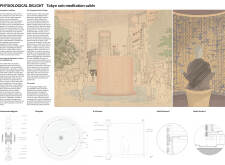5 key facts about this project
The Physiological Delight: Tokyo Rain Meditation Cabin is located in Tokyo and emphasizes a blend of natural elements and urban life. The design centers around water, reflecting its importance in Japanese culture and serving as a place for meditation and calm. Users can find a retreat from city life, experiencing a space that encourages connection with nature.
Spatial Organization
The layout of the cabin promotes an open and airy feeling, facilitating natural light and views from various angles. Users can move freely through the space, discovering areas designed for reflection and contemplation. Water features are positioned throughout, contributing to a peaceful soundscape that enhances the overall experience. This thoughtful arrangement allows individuals to engage with their surroundings while finding moments of stillness amidst the urban environment.
Materiality and Aesthetic
Materials play a significant role in creating the cabin’s serene atmosphere. Finely grained wood is chosen for interior surfaces, bringing warmth and comfort to the space. Bamboo serves as a structural element, linking the design to traditional Japanese building practices and promoting sustainability. Polycarbonate is used for some walls, allowing light to enter and providing views of the outside landscape. This combination of materials connects the interior with nature, creating a harmonious environment.
Therapeutic Qualities of Water
The design highlights the calming effects of water, an essential aspect of Japanese culture. By incorporating water as a main feature, the cabin addresses modern issues like stress and disconnection from nature. The sounds created by flowing water contribute to a sensory experience. Visitors are encouraged to interact with their environment meaningfully, fostering a sense of well-being and tranquility.
A distinctive element of the cabin is the bathroom, which offers a space for personal reflection while providing views of nature. This area elevates a common function into a chance for contemplation, blending utility with moments of peace. The design encourages users to pause and engage fully with their surroundings, reinforcing the connection to the natural world.



















































